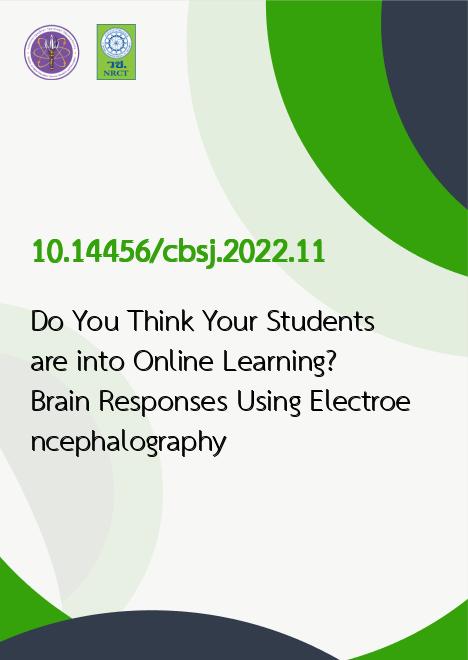
|
Do You Think Your Students are into Online Learning? Brain Responses Using Electroencephalography |
|---|---|
| รหัสดีโอไอ | |
| Creator | Arisaphat Suttidee |
| Title | Do You Think Your Students are into Online Learning? Brain Responses Using Electroencephalography |
| Contributor | Chutima Ruanguttamanun |
| Publisher | Chulalongkorn Business school, Chulalongkorn University. |
| Publication Year | 2565 |
| Journal Title | Creative Business and Sustainability Journal |
| Journal Vol. | 44 |
| Journal No. | 2 |
| Page no. | 80-94 |
| Keyword | Cognitive, EEG, Brain, Affective Cognitive, Online Instruction |
| URL Website | https://cbsreview.cbs.chula.ac.th; https://so01.tci-thaijo.org/index.php/CBSReview/index |
| Website title | THAIJO; Creative Business and Sustainability Journal |
| ISSN | 2821-9236 |
| Abstract | The cognitive level of students can reflect the learning performance that results from participation in learning activities in a traditional classroom, which an instructor can support and monitor accordingly. However, it is complicated for online learning. In this study, we used electroencephalography or EEG to investigate students' learning performance for online learning. A cognitive effort index (CEI) application was connected through an EEG headset and used to identify the level of cognitive performance, and a system usability scale (SUS) questionnaire was used to examine student satisfaction. Thirty-six of the students had at least 2 years of experience both on-site and online learning and were enrolled in the controllable instructions: subjects, settings, and durations. The findings of this study surprisingly showed that more than half (22 students) fell into an affective cognitive engagement pattern (AF), 12 students fell into an effective cognitive engagement pattern (EF), and only 2 students indicated a low cognitive pattern. These results showed that most students were significantly attentive to the online activity and only a few students were not able to stay focused during the online activity, in other words, learning in the class online could be as attentive as in the traditional class. The adoption of EEG techniques and EEG interpretation software can reflect awareness and attention in many areas, such as consumer research, consumer behaviors, digital content, and the experience of online education. This study may suggest that Thai business practitioners and marketers adopt EEG to explore consumer behavior.collected from questionnaires sent to the Chief Audit Executives of Thailand's listedcompanies. The response rate was 17.7%, with 126 companies responding. Afterwards, thematching secondary data about the governing body were collected from the annual registrationstatement.Using the covariance-based structural equation model (CB-SEM) method, the empiricalanalysis concludes that while the governing body has no direct effect, it has an indirect effecton internal audit quality through internal audit support. Therefore, to improve the quality ofinternal audit, the governing body - board of directors and audit committee - should provideadequate resources and competence to internal audit, as it is an integral part of effectivecorporate governance. This study contributes to the literature on determinants of internal auditquality in a developing country, Thailand. It also contributes practically by assisting regulatorsin determining the qualifications and competence of internal audit personnel. Last, it raises theboard and audit committee awareness of the importance of allocating adequate resources tointernal audit, especially in a volatile, uncertain, complex, and ambiguous (VUCA) world. |